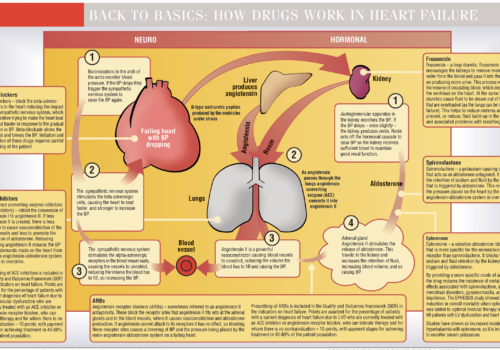Practice-based commissioning – in which practices and other primary care professionals commission services for their patients – is the latest strategy designed to improve the fit between patients’ needs and service provision. In this article, we take a detailed look at why practice-based commissioning has been introduced, what it will mean in practice and how it will work with other purchasing strategies currently operating.
Back to Basics: How drugs work in heart failure
Mending hearts and brains: the clinical case for change
Over my lifetime, treatment for heart disease has improved beyond recognition. For the last six years, I have had the privilege of leading a programme that has accelerated that change, reducing waiting times, bringing in new treatments, training more specialists, and ensuring patients have more and better choices available. I am now working to repeat those strides forward for stroke, the brain’s equivalent of heart attack. There are a similar number of strokes to heart attacks, but this equally devastating condition has been slower to catch the medical and public imagination in this country. With our ageing population, it represents a growing challenge for the future.
Making sense of myocardial perfusion scans (MPS)
More and more of our cardiac patients are having scans to check what is going on in their hearts. There were about 1,200 single photon emission computed tomography (SPECT) scans per million population in the UK in 2000, according to the British Nuclear Cardiology Society (BNCS) survey. The National Institute for Health and Clinical Excellence (NICE) has recommended this should increase to about 4,000 scans per million population per year, based on current revascularisation and coronary angiogram rates. This article explains what is involved in a myocardial perfusion scan (MPS), giving you the information to answer your patients’ questions.
Ready, steady, go: making sense of food labels
If people are going to make informed decisions about what they eat, they need to know the contents of the food they buy. Food manufacturers and supermarkets are starting to get the message, with some adopting the ‘traffic light’ system of labelling on the front of food packs. How do we interpret food labels and help our patients to make sense of what they mean so they can eat more healthily?
Stroke and TIA management
Tessa, age 68, rarely attends the surgery. She arrives on a Monday morning, however, saying that she had a ‘funny turn’ over the weekend. “I couldn’t think straight and my words came out all wrong. My arm was tingling like no-one’s business so I took to my bed to sleep it off. I still feel a bit queer this morning so Pete said I should pop down and get checked over.” What could be the problem with Tessa and what should you do?
Editorial
“A little knowledge that acts is worth infinitely more than much knowledge that is idle,” to quote the Lebanese poet, Kahlil Gibran. Well, that’s what the British Journal of Primary Care Nursing (BJPCN) is all about – putting knowledge into action. And it sums up what primary care nurses do too. We are not people who sit about debating what to do, we get on and do it.
You and your treatment: starting on your statin
Inhaled insulin: a breath of fresh air in diabetes
How to Get Top Marks for Identifying and Managing Atrial Fibrillation
Editorial
Well, spring has sprung! The first few months of each year are a good time to look forward to the challenges ahead. This can be rather daunting, but the bright flowers of spring give us glimpses of hope. In the same way, we hope that this issue of BJPCN can – like a bunch of daffodils – brighten up your day-to-day work in coping with the “warp speed” of change in the NHS.
The Keys to Optimising Lipid Management
Primary healthcare professionals have been set a series of challenges and dilemmas for the management of lipids in the updated Joint British Societies’ (JBS) guidelines for the prevention of cardiovascular disease (JBS2). In this article, we review the changes in emphasis of the new guidelines – teasing out how they can help to further reduce our patients’ risk of cardiovascular disease with tougher cholesterol targets than ever before, together with practical advice on how to achieve these targets.





















